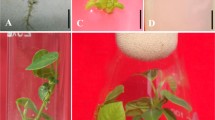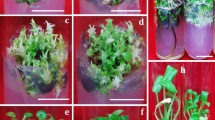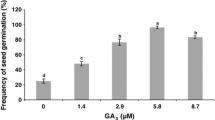Abstract
In the normal form of Mammillaria elongata, shoots were regenerated in vitro, through callus, from tubercle explants excised from the upper part of the branch and cultured on Murashige and Skoog medium (MS) with 1.07 μM α-napthaleneacetic acid (NAA) and 22.20 μM 6-benzylaminopurine (BA). A high percentage of tubercles explants of the M. elongata cristate form, excised from the tip of the branch and cultured on MS with 0.54 μM NAA and 0.44 μM BA or 1.07 μM NAA, responded by initially forming an inflated cristate shoot, which gave cristate and normal shoots, without callus intervention, when transferred on basal MS. Callus formed on cristate tubercles explants gave both cristate and normal shoots when transferred onto basal MS. Normal and cristate shoots were rooted in vitro on MS with 9.84 μM or 0.98 μM indole-3-butyric acid, respectively, and established ex vitro. In both normal and cristate form, the differential response appeared to be associated with the site of the explant excision. The formation of shoots was influenced by the season of culture; i.e., explants excised in October had a higher shoot formation rate than those excised February.
Similar content being viewed by others
References
Boke NH & Ross RG (1978) Fasciation and dichotomous branching in Echinocereus (Cactaceae). Amer. J. Bot. 65(5): 522-530
Fay MF & Gratton J (1992) Tissue culture of cacti and other succulents: a literature review and a report on micropropagation at Kew. Bradleya 10: 33-48
Hubstenberger JF, Clayton PW & Phillips GC (1992) Micropropagation of Cacti. In: Bajaj YPS (ed) Biotechnology in Agriculture and Forestry, Vol 20 (pp. 49-68). Springer-Verlag, Berlin
Johnson JL & Emino ER (1979a) Tissue culture propagation of cacti. Cact. Succ. J. (US) 51: 275-277
Johnson JL & Emino ER (1979b) In vitro propagation of Mammillaria elongata. HortScience 14(5): 605-606
Mehra PN & Cheema GS (1980) In vitro studies on Mammillaria elongata var. tenuis. Phytomorphology 30: 241-249
Murashige T & Skoog F (1962) A revised medium for rapid growth and bioassays with tobacco tissue cultures. Physiol. Plant. 15: 473-497
Nilsson O, Moritz T, Sundberg B, Sandberg G & Olsson O (1996) Expression of the Agrobacterium rhizogenes rolC gene in a deciduous forest tree alters growth and development and leads to stem fasciation. Plant Physiol. 112: 493-502
Thimann KV & Sachs T (1996) The role of cytokinins in the ‘fasciation’ disease caused by Corynebacterium fascians. Am. J. Bot. 53: 731-739
Varga A, Thoma H & Bruinsma J (1988) Effects of auxins and cytokinins on epigenetic instability of callus-propagated Kalanchoe blossfeldiana Poelln. Plant Cell Tiss. Org. Cult. 15: 223-231
Author information
Authors and Affiliations
Rights and permissions
About this article
Cite this article
Papafotiou, M., Balotis, G.N., Louka, P.T. et al. In vitro plant regeneration of Mammillaria elongata normal and cristate forms. Plant Cell, Tissue and Organ Culture 65, 163–167 (2001). https://doi.org/10.1023/A:1010601328667
Issue Date:
DOI: https://doi.org/10.1023/A:1010601328667




